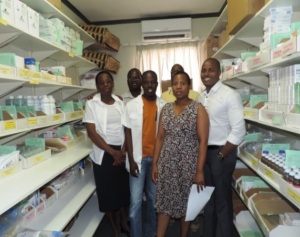The support of Community Service Pharmacists (CSPs) in Limpopo province has contributed to improvements in medicine supply management and better compliance with quality standards at the primary health care (PHC) level. In 2013, the Systems for Improved Access to Pharmaceuticals and Services (SIAPS) program, funded by the United States Agency for International Development (USAID), provided technical assistance in the introduction of an innovative new “Adopt-a-clinic” project. Led by CSPs, the project aims to improve the delivery of pharmaceutical services at the facility level.
Following the results of a National Core Standards (NCS) assessment conducted at fourteen PHC facilities in Mopani District in 2012, challenges such as low stock availability, inaccuracy of stock records, and a failure to take inventory highlighted a need for change. In many instances, the provision of pharmaceutical services was delegated to the already overburdened nursing personnel, who are expected to perform these tasks in addition to their routine clinical functions, often leading to poor stock management practices. The NCS assessment highlighted the need for an urgent solution to address these challenges.
Management of Pharmaceutical Services in the provincial Department of Health introduced the “Adopt-a-clinic” project, coordinated by Thabang Segolela (Deputy Manager Professional Development). Each CSP had to adopt a maximum of 10 PHC facilities linked to the hospital at which he or she was employed. In South Africa, all newly qualified pharmacists are required to perform one year of community service in a public-sector health facility. The objectives of the “Adopt-a-clinic” initiative were to improve medicine management practices at PHC facilities and ensure NCS compliance.
The CSPs visited facilities and, together with stakeholders, identified areas in need of improvement. Technical assistance was provided by SIAPS, which also facilitated the training of PHC nursing personnel and CSPs in areas such as medicine supply management and the use of NCS tools.
RESULTS

Photo: B. Phiri, SIAPS.
The results of the project include greater medicine availability, compliance with NCS, and improved medicine supply management practices, including regular stock inventories and the use of stock cards that show the minimum and maximum stock levels. The CSPs’ interventions contributed to an average increase in stock availability across the province, from a baseline of 53% to 73%.
There was an improvement in stock record accuracy from a baseline of 43% to 71% in the Vhembe and Waterberg districts. Furthermore, an improvement in stocktake variance was reported in the Mopani and Waterburg districts, from 23% in March 2013 to 9% in September 2013.
The project also helped reduce the burden on nursing personnel and improve the quality of health care services at PHC facilities. Consequently, waiting times have been reduced and patients receive the medicines they need within 10-15 minutes. Professional Nurse Gladys Ratsatsi from Lebaka Clinic hailed the positive influences of the project. “The CSP has been very helpful,” she said. “She comes biweekly and has taught us how to regularly check stocks and ensure good stock management practices.”
Following these encouraging outcomes, the Department of Health decided to make this support compulsory for all CSPs. “I am very happy with this milestone,” Segolela said. “I now want all hospitals that receive CSPs to take ownership of the initiative and ensure that their CSPs make a positive contribution to improving pharmaceutical services in clinics.”
CONCLUSION
The involvement of CSPs at the PHC facility level has contributed to improvements in medicine supply management and better compliance with the NCS. The project has proven to be successful not only in improving the quality of pharmaceutical services at the PHC level, but also in building the capacity of these young entrants into the pharmacy profession.

